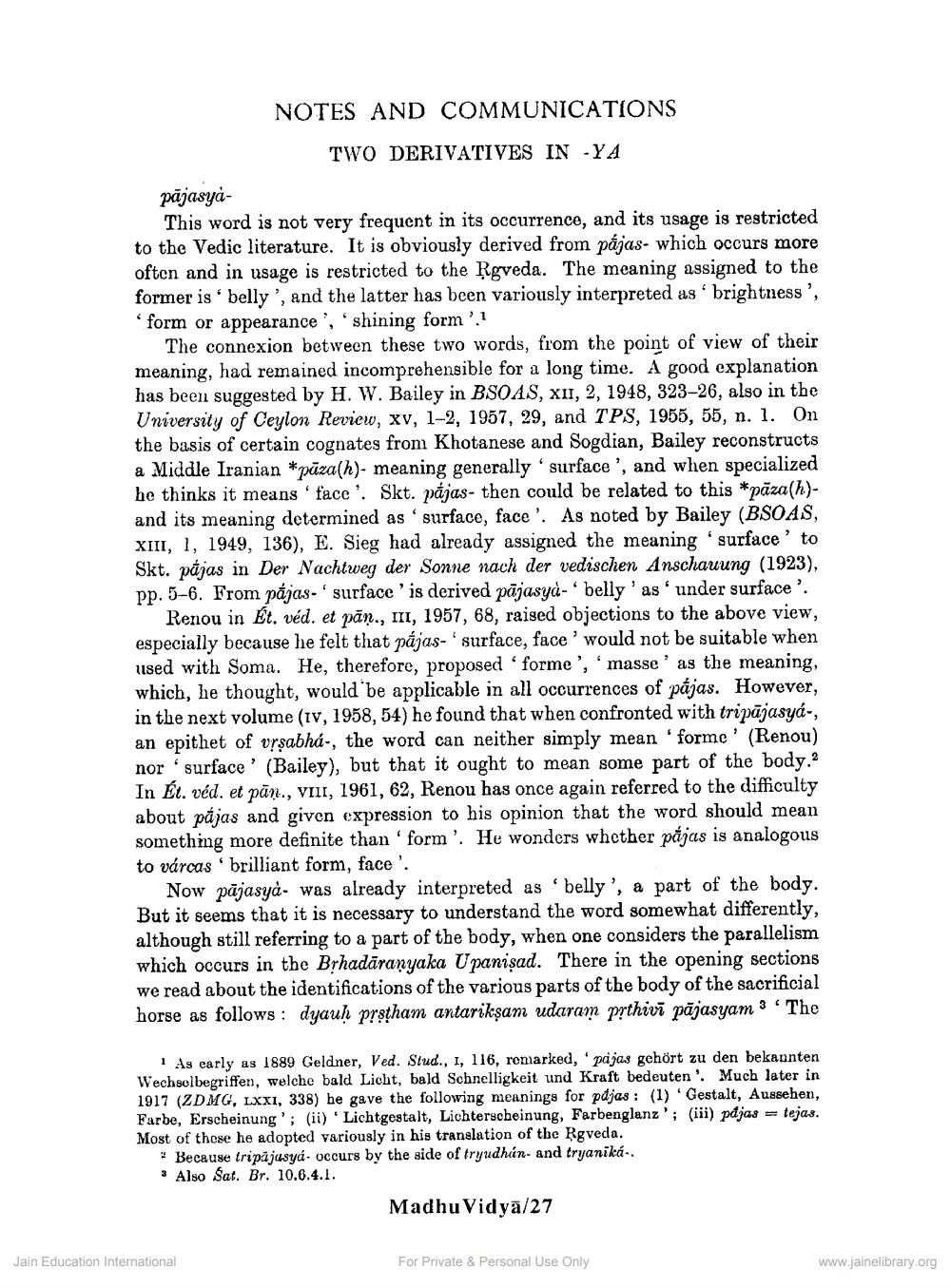________________
NOTES AND COMMUNICATIONS
TWO DERIVATIVES IN YA
pājasyȧ
This word is not very frequent in its occurrence, and its usage is restricted to the Vedic literature. It is obviously derived from pájas- which occurs more often and in usage is restricted to the Rgveda. The meaning assigned to the former is belly, and the latter has been variously interpreted as 'brightness', 'form or appearance, shining form '.1
The connexion between these two words, from the point of view of their meaning, had remained incomprehensible for a long time. A good explanation has been suggested by H. W. Bailey in BSOAS, XII, 2, 1948, 323-26, also in the University of Ceylon Review, xv, 1-2, 1957, 29, and TPS, 1955, 55, n. 1. On the basis of certain cognates from Khotanese and Sogdian, Bailey reconstructs a Middle Iranian paza(h)- meaning generally surface', and when specialized be thinks it means 'face'. Skt. pájas- then could be related to this *paza(h)and its meaning determined as 'surface, face. As noted by Bailey (BSOAS, XIII, 1, 1949, 136), E. Sieg had already assigned the meaning 'surface' to Skt. pdjas in Der Nachtweg der Sonne nach der vedischen Anschauung (1923), pp. 5-6. From pájas-surface' is derived pajasyà- belly' as under surface'.
Renou in Et, véd. et pan., III, 1957, 68, raised objections to the above view, especially because he felt that pájas- surface, face' would not be suitable when used with Soma. He, therefore, proposed forme', 'masse' as the meaning, which, he thought, would be applicable in all occurrences of pájas. However, in the next volume (tv, 1958, 54) he found that when confronted with tripajasyd-, an epithet of vrgabhá-, the word can neither simply mean forme' (Renou) nor surface (Bailey), but that it ought to mean some part of the body." In Et. véd. et päu., VIII, 1961, 62, Renou has once again referred to the difficulty about pajas and given expression to his opinion that the word should mean something more definite than 'form'. He wonders whether pajas is analogous to váreas brilliant form, face'.
Now pajasyd was already interpreted as 'belly', a part of the body. But it seems that it is necessary to understand the word somewhat differently, although still referring to a part of the body, when one considers the parallelism which occurs in the Bṛhadaranyaka Upanisad. There in the opening sections we read about the identifications of the various parts of the body of the sacrificial horse as follows: dyauh prstham antarikşam udaram pṛthivi pajasyam The
1 As early as 1889 Geldner, Ved. Stud., 1, 116, remarked, 'pajas gehört zu den bekannten Wechselbegriffen, welche bald Licht, bald Schnelligkeit und Kraft bedeuten. Much later in 1917 (ZDMG, LXXI, 338) he gave the following meanings for pdjas: (1) Gestalt, Aussehen, Farbe, Erscheinung'; (ii) Lichtgestalt, Lichterscheinung, Farbenglanz'; (iii) pdjas = tejas. Most of these he adopted variously in his translation of the Rgveda.
Because tripajasyá- occurs by the side of tryudhún- and tryaniká-. Also Sat. Br. 10.6.4.1.
Madhu Vidya/27
Jain Education International
For Private & Personal Use Only
www.jainelibrary.org




